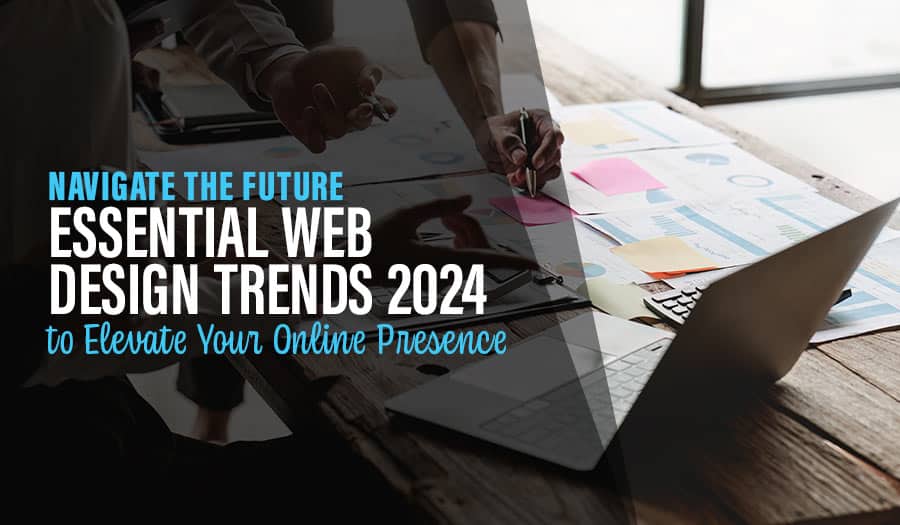Navigating web design in 2024 means anticipating and applying the freshest trends. This article cuts through the noise to highlight the key web design trends 2024 brings, poised to impact your website’s user experience and aesthetic directions.
Key Takeaways for Web Designers
- AI-enhanced user experiences, dark mode, kinetic typography, and micro animations are among the leading web design trends in 2024, all aimed at creating visually appealing, seamless, and personalized user interactions.
- Responsive design for optimal mobile use, including thumb-friendly navigation and fast load times on mobile devices, is essential to accommodate increasing mobile engagement and improve overall user experience.
- Personalization, security, and accessibility are driving web design forward, with trends in dynamic content, HTTPS standards for secure connections, and inclusive design practices making websites more user-centric and trustworthy.
Navigating the 2024 Digital Landscape: Top Web Design Trends
Web design in 2024 is all about creating websites that look good and deliver a seamless user experience. Some of the top website design trends shaping the digital world include:
- AI-enhanced user experiences
- Embrace of dark mode aesthetics
- Integration of kinetic typography
- Micro animations
One website design trend that is gaining popularity is the focus on creating visually appealing and user-friendly web pages for site visitors. This website design trend emphasizes the importance of engaging users with a seamless experience, which is in line with the latest website design trends.
The Rise of AI-Enhanced User Experiences
Artificial intelligence is revolutionizing website design by enhancing appearance, functionality, and user experience. From personalized suggestions tailored to each unique user to AI-powered chatbots that engage in conversations with users, AI is transforming the way users interact with websites, paving the way for a more immersive and personalized experience.
Embracing Dark Mode for Modern Aesthetics on Web Pages
The adoption of dark mode in website design is more than just a trend. It’s a shift towards modern aesthetics that improve visibility and reduces eye strain in low-light environments. By providing a low-contrast background images a site or app, dark mode creates an aesthetically pleasing digital experience that’s easier on the eyes.
Motion That Matters: Kinetic Typography and Micro Animations
In the world of website design, motion truly matters. The use of kinetic typography and micro animations creates engaging visuals and inaccessible user experiences that not only capture attention but also express brand identity. Some examples of how motion can enhance user interaction include:
- Transforming simple typography into dynamic messages
- Adding subtle, yet impactful micro-interactions
- Creating animations that guide users through the website
- Using parallax scrolling to create depth and dimension
These elements enhance user interaction and encourage users to engage in further exploration.
The Visual Symphony: Color and Shape in 2024’s Web Designs
The use of colour and shape in web designs goes beyond aesthetics. Pastel colours, gradients, and organic shapes are increasingly popular, offering a fresh and contemporary visual appeal to web browsers. These elements play a vital role in adding depth, serving as striking backgrounds, and subtly adding texture to website design.
Gradient Revolution: From Subtle Overlays to Bold Backgrounds
The gradient revolution has taken the web design trend and the world by storm. From subtle overlays to bold backgrounds, gradients are increasingly favoured for generating fresh website inspirations. By adding depth to web designs, gradients offer a modern look that’s versatile and visually appealing.
Geometric Shapes and Organic Patterns: A Balancing Act
The balance between geometric shapes and organic patterns is a key trend in 2024 web design. These design elements are instrumental in focusing user attention on specific products or call to action (CTAs), creating fluid and engaging user interfaces that captivate and direct user attention.
Crafting Compelling Narratives: Storytelling in Web Design
Storytelling is an art, and when applied to web design, it can enhance the overall user experience. From layering design elements to create depth and texture to using abstract shapes for engaging introductions, effective storytelling in web design engages the user and fosters a connection beyond just transactions.
Interactive Storytelling Through Scroll-Triggered Animations
Scroll-triggered animations offer a great example of a dynamic approach to storytelling in web design. By adding dynamism to webpages, these animations encourage users to continue scrolling, creating a three-dimensional, engaging experience that unfolds a narrative in a captivating way.
Video Integration: Engaging Visitors with Dynamic Storytelling
The integration of video content in web design is more than just a trend, it’s a storytelling revolution. With the preferred type of content for almost 70% of people being video, the use of embedded videos and short videos in web design engages website visitors more with dynamic storytelling and significantly reduces bounce rates.
Maximizing Mobile Engagement: Responsive Design for All Devices
As mobile usage continues to rise, responsive design has become paramount for more web designers, especially for e-commerce. By focusing on touch navigation and efficient mobile experiences, web designers can maximize mobile engagement and ensure optimal viewing by adapting to the user’s behaviour and environment.
Thumb-Friendly Navigation: Designing for One-Handed Use
Thumb-friendly web design is a key trend in 2024, placing the navigation bar, menu, and contact buttons within the reach of the user’s thumb. By designing menus for thumb navigation and incorporating intuitive gestures like swipes and taps, designers can enhance the mobile navigation experience as users scroll through, making it more engaging and user-friendly.
Speed Is Key: Optimizing for Fast Load Times on Mobile
Speed is key in the digital world, and optimizing websites for fast load times on mobile devices is essential. Techniques such as Accelerated Mobile Pages (AMP) and replacing photography with illustrations can significantly improve loading times, enhance user engagement, and reduce bounce rates.
Beyond Aesthetics: Functional Innovations in Web Design
Web design in 2024 goes beyond aesthetics, with functional innovations playing a pivotal role. From experimental navigation that provides a unique and engaging user experience to voice-activated interfaces that offer a hands-free navigation experience, functional innovations are transforming the way users interact with websites.
Voice-Activated Interfaces: The New Frontier of Web Interaction
Voice-activated interfaces are becoming increasingly prevalent in web design, catering to the rising use of smart assistants and voice-activated devices. By providing a hands-free navigation experience, voice-activated interfaces are enhancing accessibility for users and transforming the way they interact with websites.
Progressive Web Apps (PWAs): Bridging the Gap Between Web and Mobile
Progressive Web Apps (PWAs) are bridging the gap between web and mobile, providing enhanced user experiences and conversion rates. By focusing on user behaviour and testing to ensure fast load times and high usability, PWAs are becoming a key optimization approach in web design.
The Art of Minimalism: Clean and Streamlined Web Aesthetics
Minimalism in web design is all about clean aesthetics and streamlined navigation. It improves readability, guides user attention, and creates a clean and straightforward user interface. Some key elements of minimalism in web design include:
- Strategic use of white space
- Minimalist navigation
- Simple and clean typography
- Limited colour palette
- Minimal use of images and graphics
By incorporating these elements, you can create clean, minimalistic modern web design that is visually appealing and user-friendly.
White Space Wisdom: Leveraging Negative Space for Focus
White space, or negative space, is a crucial element in web design. By improving readability and guiding user attention, white space can make a web page feel open, uncluttered, and organized, enhancing the overall user experience.
Less Is More: The Impact of Ultra-Minimalist Navigation
Ultra-minimalist navigation is a key trend in 2024 for the latest web design trends. By emphasising the website’s content more than complex design elements, web designers can create a clean and straightforward user interface that enhances the overall user experience.
Personalization and Dynamic Content: A Tailored Web Experience
Personalization and dynamic content are transforming the way internet users interact with websites. Some examples of how personalization is enhancing user engagement and fostering customer loyalty include:
- Tailored recommendations based on user preferences and browsing history
- Interactive web elements that allow users to customize their experience
- Custom graphics that adapt to user behaviours, such as displaying different images based on user actions
These personalized visual elements will create a tailored web experience that enhances user engagement and fosters customer loyalty.
Custom Graphics and Illustrations: Reflecting Brand Personality
Custom graphics and illustrations are pivotal in reflecting a brand’s personality on a website. By incorporating unique visuals and animated elements that communicate complex messages, custom graphics and illustrations can tremendously enhance a brand’s unique visual appeal and contribute to a coherent brand narrative.
Intelligent Loading: Enhancing Website Performance with Smart Content Delivery
Intelligent loading is a key trend in 2024 web design. By postponing the loading of non-essential content until it becomes necessary, intelligent loading enhances website performance and reduces unnecessary wait times for content to load, contributing to a more seamless user experience.
Security and Trust: Prioritizing Data Protection in Web Design
In the digital world, security and trust are paramount. With an increased emphasis on data protection, organizations are investing in robust security measures and adopting Privacy by Design principles to regain public trust and ensure user data safety.
HTTPS as Standard: The Shift Towards Secure Connections
The use of HTTPS protocol has become a standard in web design, providing secure connections to protect user information. With SSL technology, websites can ensure:
- Data Confidentiality
- User privacy
- Protection against data breaches
- Trust and credibility among users
Transparent User Data Handling: Building Confidence Through Design
Transparent user data handling is a key design approach in 2024 web design. By disclosing data-sharing practices and holding accountability for data collected, websites can build user confidence and foster a positive relationship between users and brands.
The Evolution of E-Commerce: Next-Level Online Shopping Experiences
The e-commerce landscape is evolving, with the following trends becoming significant:
- Illustrated characters
- Asymmetrical layouts
- Micro-interactions
- Scrolling animations
- Claymorphism
- Retro design elements
E-commerce websites continuously innovate to create a unique, visually interesting, and emotionally engaging online shopping environment, often incorporating interactive website features.
Immersive Product Displays: 3D Models and AR Integration
Immersive technologies such as 3D models and AR integration are transforming the e-commerce landscape. By providing a more engaging shopping experience, these technologies increase customer confidence in their purchase decisions and boost conversion rates.
Checkout Innovation: Streamlining the Path to Purchase
Checkout innovation is pivotal in minimizing friction and enhancing the user experience during the online purchase process. Techniques such as price personalization and personalized deals contribute to a frictionless checkout experience, improving customers’ purchasing journeys and potentially increasing a business’s conversion rates and sales.
Accessibility for All: Inclusive Design Practices
Inclusive design practices are crucial in ensuring accessibility for all. By engaging visual elements, improving accessibility for all visitors boosting SEO and enhancing conversion rates, inclusive design ensures a seamless user experience for everyone.
Summary
In conclusion, 2024 is set to be a groundbreaking year for web design, with trends such as AI-enhanced experiences, dark mode aesthetics, kinetic typography, micro animations, gradient revolution, geometric shapes, organic patterns, scroll-triggered animations, thumb-friendly navigation, voice-activated interfaces, Progressive Web Apps (PWAs), minimalism, white space wisdom, ultra-minimalist navigation, personalization, dynamic content, custom graphics, intelligent loading, HTTPS protocol, transparent user data handling, immersive product displays, 3D models, AR integration, and checkout innovation shaping the landscape of web design.
Frequently Asked Questions
What are the top web design trends for 2024?
In 2024, the top web design trends include AI-enhanced experiences, dark mode digital aesthetics, kinetic typography, micro animations, gradient revolution, geometric shapes, and organic patterns.
How is AI revolutionizing web design?
AI revolutionizes web design by enhancing user experience with personalized suggestions, recommendations, and chatbot interactions tailored to each user, ultimately making the user experience more engaging and efficient.
What is the importance of storytelling in web design?
Storytelling in web design is crucial for engaging users and fostering a deeper connection beyond mere transactions. It enhances the overall user experience, whether through interactive storytelling, scroll-triggered animations, or dynamic video integration.
How is minimalism applied in web design?
Minimalism in web design is applied through clean aesthetics, streamlined navigation, strategic use of white space, and ultra-minimalist navigation to improve readability, guide user attention, and create a clean and straightforward user interface. This approach enhances the user experience and creates visually appealing websites.
What is the significance of transparent user data handling in web design?
Transparent user data handling in web design is crucial for building user confidence and maintaining trust between users and brands. Websites can foster a positive relationship with users by disclosing data-sharing practices and being accountable for the data collected.
Take your business to the next level with a Pixel Fish Website.
Check out some of our latest Website Design projects.
View some case studies of our website design work:
Family First Care
Matthews Steer
Pacific Power Electrical
Nsure Insurance Advisors
Further Information
Why you should use Elementor for your new WordPress Website
8 Cutting-Edge Web Design Trends to Incorporate Into Your Website
Top E-Commerce Web Design Trends
Practical Design Website Tips for a Successful Online Presence
The Top ECommerce Web Design Trends you need to know
7 Unbeatable Business Digital Marketing Trends



